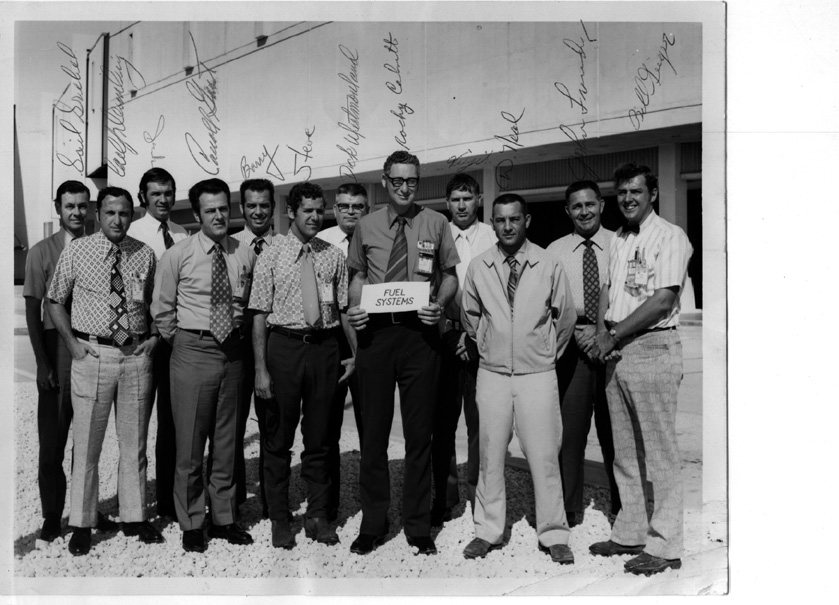
In 1964, I was medically separated from the Navy in California at age 23 with a wife and a newborn child. My parents were then living in Hollywood, Fl so we headed East to see them and figure out what a Naval Academy grad was going to do with the rest of his life. After searching the Miami want ads I chanced upon an ad from Boeing looking for engineers on the Apollo program at KSC. I interviewed and was hired by Boeing by John Redmond into the Systems Engineering department in November of 1964. I was about the four hundredth person hired by Boeing (led by Wendall Clark) which would eventually grow to several thousand.
1964-1973
Shortly after hiring in I was assigned to
the team preparing Boeing's response to the Apollo/Saturn RFP and acted
as coordinator along with Charlie Friend to compile the inputs of all of
the many engineering disciplines into a proposal. Based on my performance
in that task, Mitch Hart requested me to be his Administrative Assistant
while setting up and hiring personnel for the Procedures and Specifications
and Requirements group. During the buildup this was exciting but
I became bored and wanted to become part of the hands on Launch Team.
I requested a transfer to the Test Engineering group under Howard (Hardy
Hardcastle) and reported to the Liquid Hydrogen group on Pad 39A under
Rocky Calvetto. The Lead engineers were Stu Woodward and Wes Westmoreland.
Gail Griebel patiently taught me the intricities of the LH2 System. Jack
Kramer was my cohart in getting every job done right. About that time they
were conducting cold flow tests to validate the LH2 transfer system and
preparing for the first Tanking test of the non flight Facilities Integration
Vehicle, SA-500F. I was assigned to monitor the S-IVB tanking as
C4HU in Firing Room One and supported the rest of The Saturn V launches
from one console or another. On SA-508 I controlled the LH2 tanking
as CCLH. Incidentally this was Apollo 13.
We often referred to the Liquid Hydrogen system as a big vacuum system that incidentallly transferred hydrogen. I became expert in operating vacuum pumps and performing mass spectrometer leak checks of the vacuum jacketed piping. There were about forty vacuum sections each on LC39 A & B; and over twenty on each of the three LUTS (Umbilical Towers). Of course we also had to offload countless trailers of LH2 into the 800000 gallon storage dewer, perform component, subsystem and system level tests. The burn pond where vented hydrogen gas was disposed of was a continuous challenge with approximately 1500 individually adjusted bubble caps to maintain the proper vent pressures. We also prepared all of the system level test procedures and worked with the Test Conductors on the Launch Countdown and Tanking procedures. Also there were endless modifications and problems to resolve.
My favorite Apollo memory was performing my final walkdown of the LUT just before launching Apollo 11. We were so aware of the enormity of what we were about to do. The MSS had been rolled back revealing the enormous Saturn V to full view. It was after dark and the spotlights were casting their cones of illumination on the stack. I was virtually alone on the tower as I examined every component of the LH2 system to be as sure as I could that "my" system would do its job. It was just me and the Saturn V with a bright moon overhead. I would look at the moon , then at the rocket and think, " I don't want to be anywhere but right where I am right now"
On the eve of the fortieth anniversary of Apollo 11 I was confused because of the above story as to whether I was on the prime Firing Room crew or was on the back up team for that historic launch. I wrote my fellow systems engineer Jack Kramer who wrote the following:
Wayne Gray and Red Davis, a safety guy and I were on the launcher while you detailed the plans for torquing the valve bolts and leak checking the valve. When we warmed up the valve with the hard hat bucket brigade I came back to the firing room and you and I controlled the level by cycling the main fill valve using the slow fill mode. If we hadn't controlled the leak and maintained proper LH2 level the launch would have been scrubbed for the day." "You were C4HU for Apollo 11. I was CPH1. You were in charge of the SIVB level while we bypassed the replenish valve because of the leaking valve. I have (at home) the Procedure change you wrote,(click here) so we could do it. (For the actual voice transcripts (click here).) Those we long days. You probably did the walkdown of the system then came to the firing room. It was always the best on night shift looking at that monster in the floodlights.
I was twenty-eight years old when we landed on the moon, responible for loading 600000 gallons of LH2 on the "moon rocket". The managers were in their early thirties and someone over forty was "the old man". Exciting times!
Things were way different back then safeywise. Often I would climb outside of the handrails on the 240 foot level of the tower and shinny out on the vent line to inspect a pipe or expansion joint. Never gave a thought to a safety belt! During one cold flow test I got permission to stand out at the burn pond to monitor the flame patterns during venting which caused a hundred foot square by hundred foot high conflagration. And once we had a leak on the twelve inch vent valve from the storage tank. At that time helium for inerting was a rare and expensive commodity and it was going to take months for the tank to warm up enough to inert it with nitrogen so we decided to remove the vent valve with a partially full tank. We all had on anti static clothes and leg stats and fans to blow the hydrogen away, but as soon as the flange was loosened we were enveloped in a cloud of hydrogen vapor. I was sure an explosion would ensue, but we had little choice but to complete the job. Somehow we survived.
After the Apollo program was prematurely canceled, I was assigned to modify Pad 39B to support the launch of the Saturn-IB from the milkstool for the Skylab program. What a clever idea that was! During that period I received my MBA from FSU. After supporting all of the S-IB launches to Skylab, as the workforce was being decimated, I volunteered for layoff when a job launching Atlas-Centaur became available at LC36.
While I'm in a story telling mood here's another Tale from the Rocket Wars. and apologies to Stew Woodward, my old lead engineer whose account I've freely plagarized.
For this story I was just an observer from my liquid hydrogen post in the Firing Room, but it's a good one. By the way Apollo 13 was lifted on Saturn 508 and for this flight I had been honored to operate the main LH2 loading console directing the loading operation.
Liquid oxygen which combined with either RP-1 (kerosene) or liquid hydrogen powers the Saturn V rocket was stored on the perimeter of the launch complex in a large 800,000 gallon insulated tank (as was liquid hydrogen on the other side of the Pad). It was transferred across the field and up the Umbilical Tower using huge centrifugal pumps. Because the main transfer line was uninsulated a long chill down operation had to be performed to cool the line and provide high quality LO2 to the rocket. So hours before the loading of the Saturn V started, a small amount of LO2 (about 25000 gallons!) was allowed to flow through the pumps,lines, and launch vehicle and out a drain into a ditch in the adjacent swamp. This was normally not a problem. The LO2 vaporized and the wind blew it away. It quickly mixed in with O2 already in the air.
Apollo 13 was different. and we all know what happened later on its way to the moon. But this tale has nothing to do with that disaster.
We were doing a CDDT, Countdown Demonstration Test, a simulated countdown including fueling the rocket to show we could do it right on the Apollo 13 launch day. The day was overcast, not a breath of wind and the humidity and temperature were just right. On that day the pure oxygen draining into the ditch next to the road did not dissipate. It just sat in the ditch. You have all heard the stories of what happens in a hospital oxygen tent if you light a cigarette. In a 100% oxygen atmosphere it almost explodes it burns so fast.
The Security Police manned the guardhouse at the entrance to the launch pad. Just before we started loading the launch vehicle with fuel and oxidizer the pad was officially cleared, except for the police who did a final sweep of the Pad. They would get in their patrol cars and drive around the pad perimeter road with red lights flashing and loud speakers blaring, "Clear the Pad." They would then report to the test conductor that the pad was officially clear for propellant loading and launch and exit the Pad through a gate near the LO2 facility. That day as we followed the patrol cars around the pad and out the gate on our console television monitors, they entered a fog bank where the dirt road was near the ditch. Normally this would have been condensed moisture from the humid air caused by the cold oxygen gas, but for Apollo 13 it evidently was pure oxygen. As the patrol cars drove though the cloud the hot grease on the engines caught fire. We saw the Security Police jump out and run to safety. A second car and then third followed and exploded in flame. No one knew what the heck was happening. We watched as the patrol cars burned with the oil, grease and gasoline acting as the fuel and the pure oxygen. The vehicles melted down to the engine blocks. Fortunately all of the patrolmen escaped. Once the excitement died down we resumed the simulated countdown. Never again did the police use that Pad exit!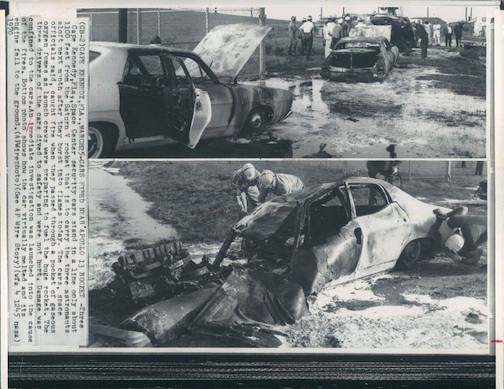
All of us who worked on the Launch Pad during Apollo took continuous safety courses in things like safety showers/eye washes, Scott Airpack breathing, safety harnesses, hazardous gases, pad egress, etc.
My favorite was always fire training. We would learn to use fire extinguishers on small fires and hoses on actual large oil fires.
I had done this course every year and while exciting was relatively safe. Well one year we were fighting fires and the day was extremely windy with about a 30 mph north wind. One drill was for five guys to follow a trail which had several small fires. The first and last had extinguishers and the center three were just along for the ride. Well, on this day the wind had whipped the flames to 20 feet high and I questioned the professionals whether it was safe. They said to quit being a chicken and go for it.
We entered the trail with me being the last guy all of us in coveralls, gloves, and breathing apparatus. The first guy attempted to knock down the first raging fire, but it flared right up. I hit it with my extinguisher to no effect. Suddenly we were surrounded by a wall of flame and all discipline was lost. We all bailed out through the wall of fire.
The fire fighters called us together to chew us out for our failure, but by this time I realized that all my exposed skin was feeling hot. I told them I needed to go to Medical and they said nonsense. I insisted and another engineer said he was also burned. At Medical they took it seriously and quickly applied ice water pads to our burns.
The other engineer was burned worse than me, but both of us lost all the skin on our necks, ears, wrists and anywhere not covered. The medical personnel said we were within seconds of being burned to death.
After the "smoke" cleared the Fire Chief in charge was fired and they toned down this safety course.
Life was sure exciting back then.
Yet another self disparaging Tale from the Space Wars.
This one involved what happened to me at a NASA Awards ceremony.
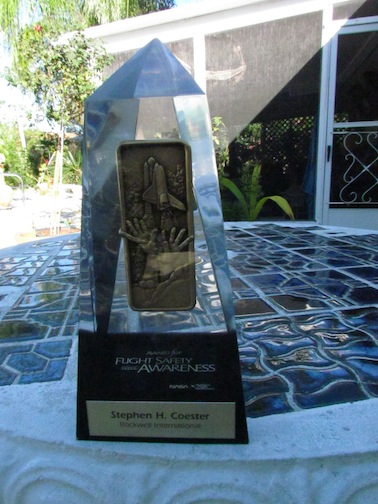
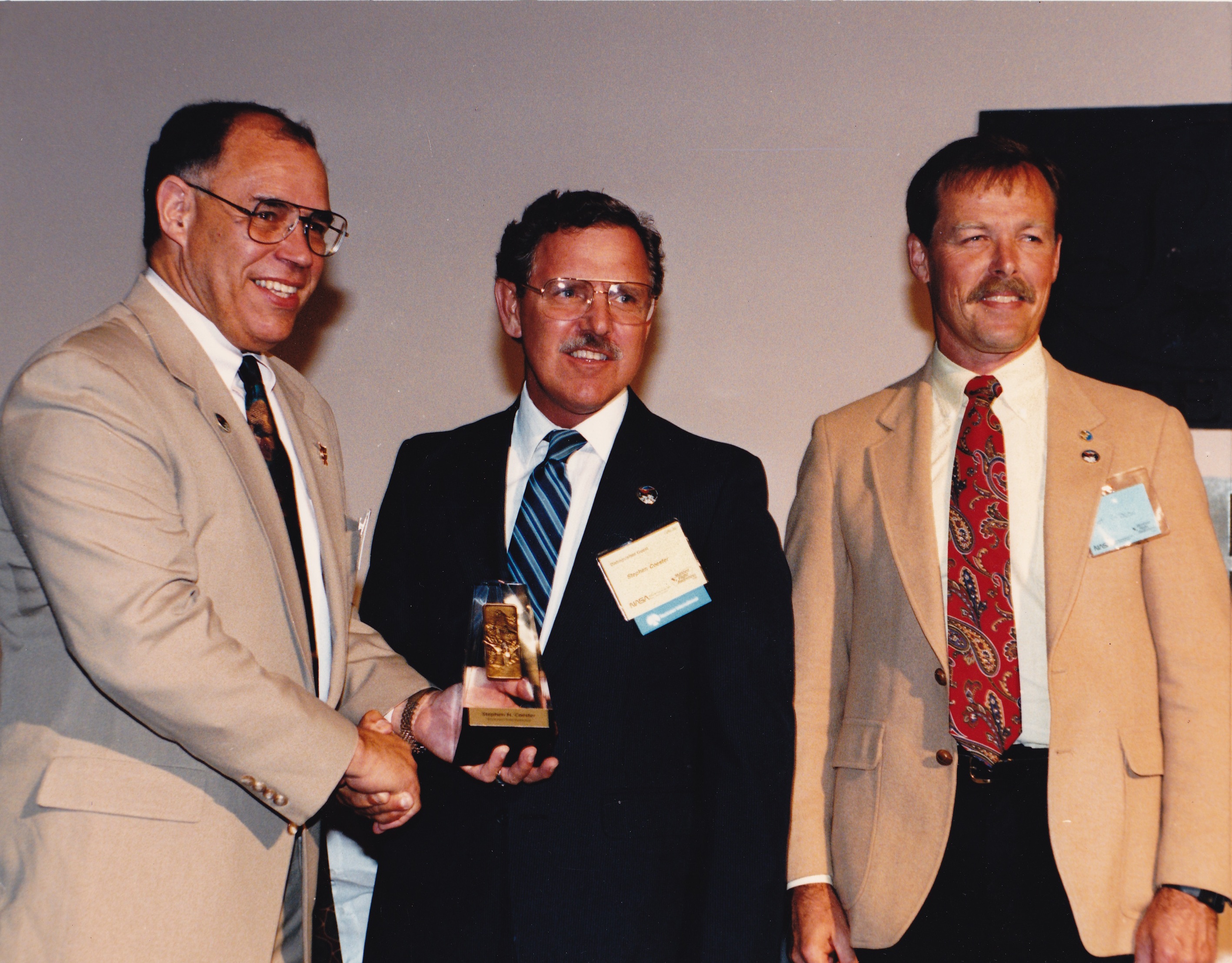
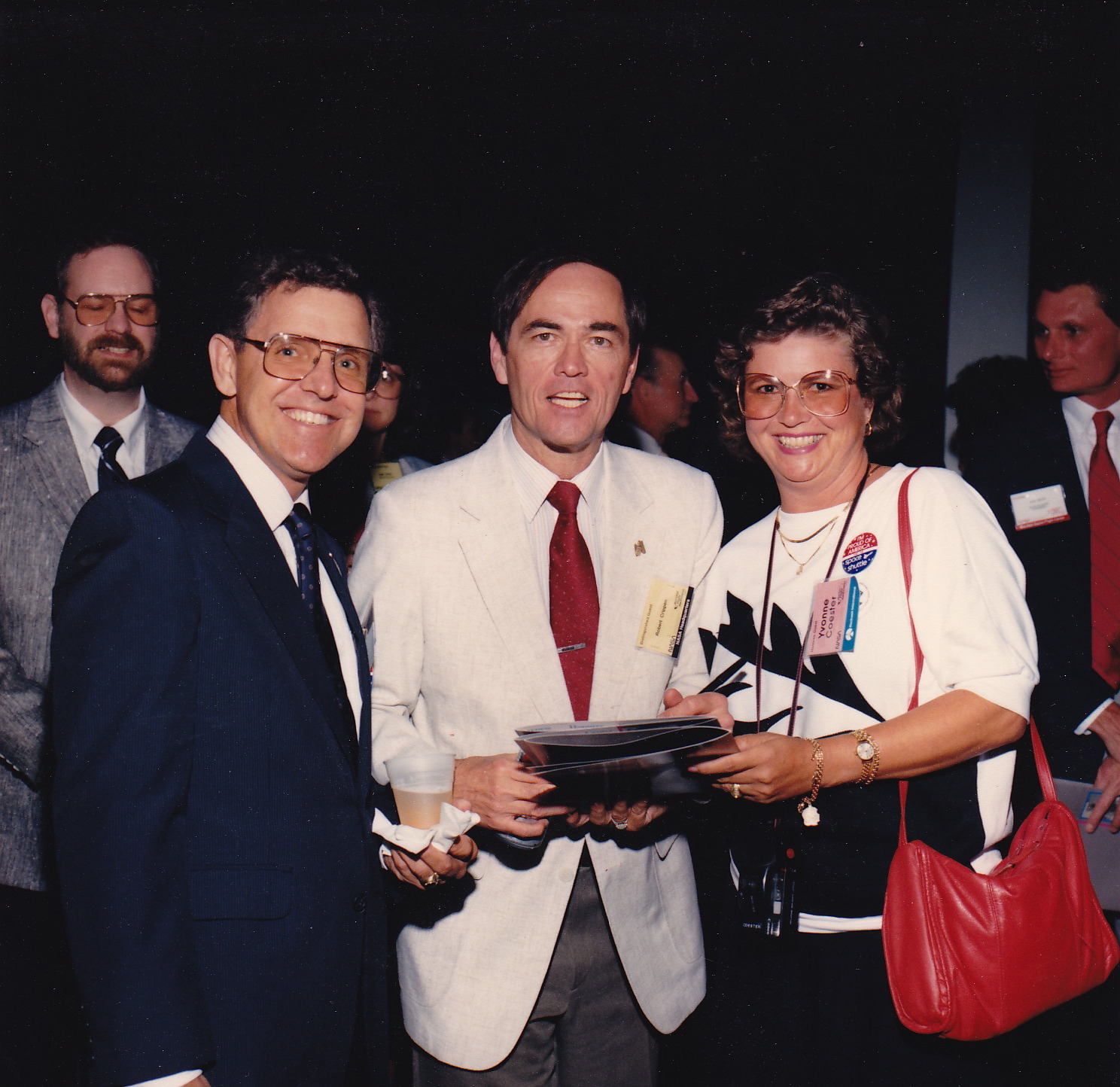
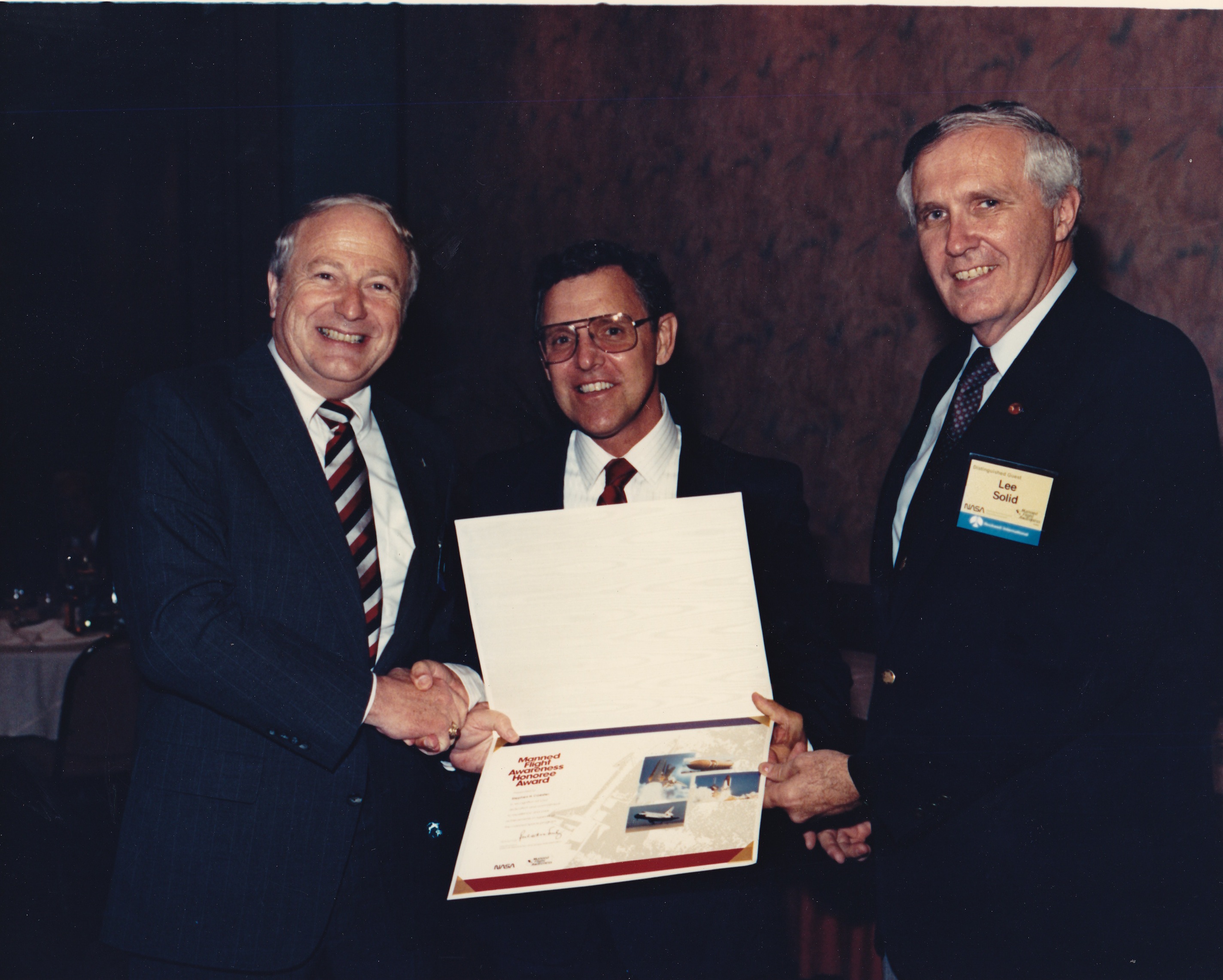
Almost Headline: Space Scientist Speared By Safety Award
Well not quite, but what happened was that along with three others was the recipient of the NASA Manned Spaceflight Safety Award for our actions in an event that could have caused a Space Shuttle disaster. It's highly technical but perhaps I'll try to explain in another post. (later I did write this up. Click Here for that story.
The event was held at the Cocoa Beach Radisson Resort and involved a reception and drinks for hundreds of NASA and contractor managers, astronauts and other dignitaries just so they could hand us our awards. At one point I met this attractive young lady in civilian clothes who I took to be about college age. Turns out it was Eileen Collins who was an astronaut and Air force colonel, who had not yet flown but who went on to become the first female Space Shuttle Commander!
Finally the big moment came and we recipients were lined up on a stage and handed our trophies by Fred Gregory, another astronaut who was now the NASA Deputy Administrator in Washington, D.C.
After the ceremony the stage became crowded with all the people wanting to shake our hands. Finally it was pretty much over and I turned around to leave the stage. I didn't realize that I was right on the edge and I tumbled the four feet to the concrete floor clutching the award. I smashed into the concrete and the sharp end of the award was fortunately between two of my fingers, not in my palm, and it slid between my ribs and my arm barely missing impaling me.
I was understandably pretty shook up but pretty much unhurt. Also I was quite embarrassed but as I painfully got to my feet not one of the hundreds of attendees had even noticed my fall. So I dusted myself off and limped around trying to act if nothing had happened. Why oh why does everything happen to me?
Tales from the Rocket Wars Sometimes I feel we should have received "Darwin Awards" instead of Performance Awards.
You get a twofer on this entry.
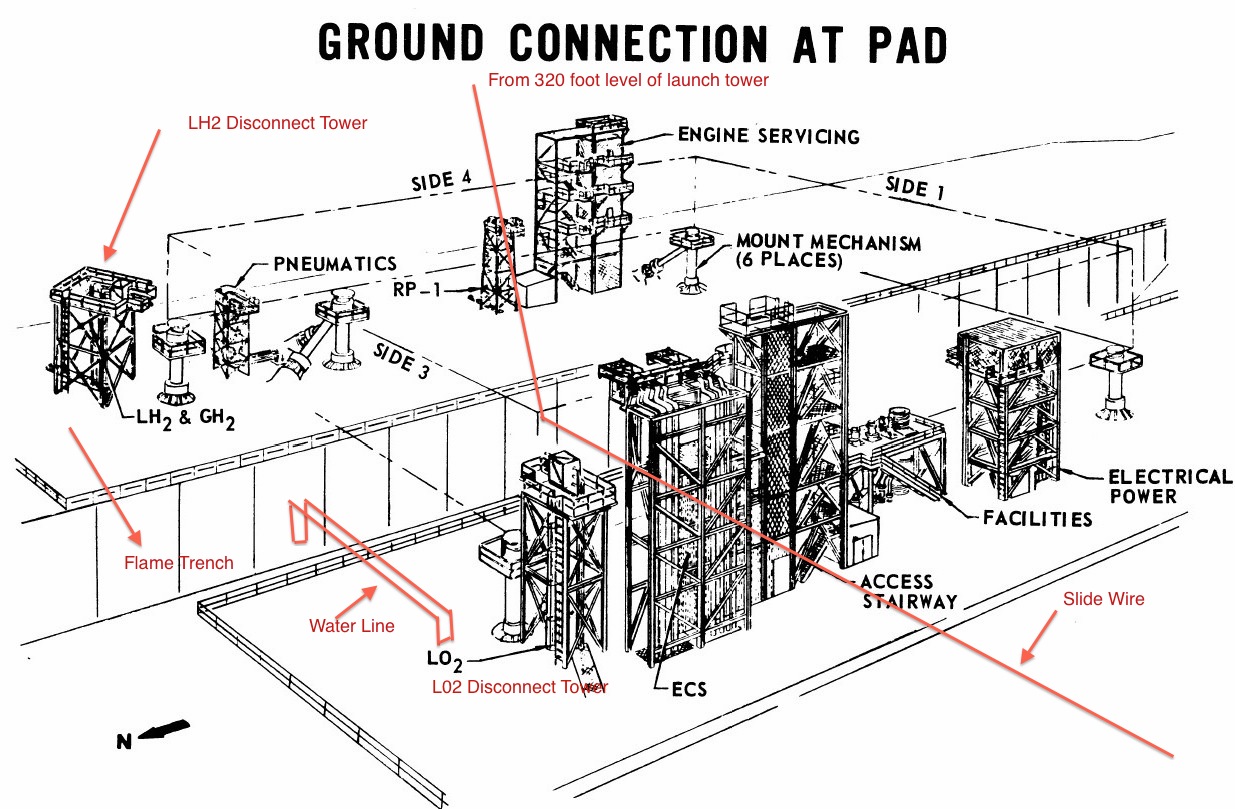

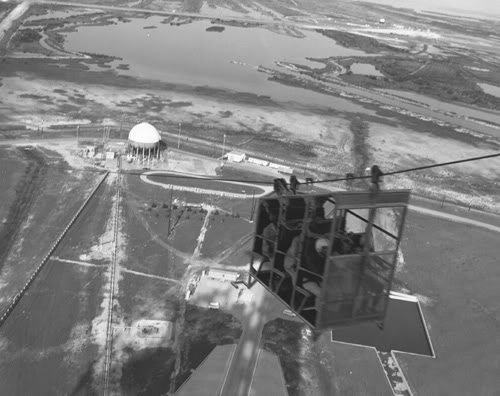

The first I'll call Slidewire for Dummies.
During planning for Apollo astronaut safety a big rubber room was constructed under the pad.The idea was that in case of a fire or other emergency the astronauts would exit the capsule, ride the elevator down to inside the launch platform, slide down a teflon chute into the safe room and ride out whatever was happening above.
Soon they figured out that if the disaster was below them they probably would never make it to the room so they started designing a slide wire which would take them from the 320 foot level of the tower, just outside the capsule to 2300 feet away from the pad.Eventually they decided on a basket system where the astronauts would climb into the basket, hit a release and zoom down the wire. The same system was used for Space Shuttle but fortunately it never had to be used on either program.
One of the early designs was to have the astronauts wear a harness that would clip onto the wire. One day I was walking in the pad surface near the L02 Disconnect Tower (see sketch) and I heard a scream to take cover. They were testing the harness system with a life-sized dummy and it fell off the wire at 320 feet above the pad surface smashed into the L02 Disconnect tower, bounced off and landed pretty near me. so much for that idea.
The second Tale is about a water test on the launch pad. Water for fire suppression and exhaust cooling was supplied to the pad through giant 36 inch pipes and at high pressure to reach all the way to the top of the Saturn rocket. One day I was performing some test on the LH2 Disconnect Tower and noticed tech configuring the water system. They connected a reducer to the 36 inch flange bringing it down to 12 inches. Then ran a pipe about forty feet from there over to the flame trench with an elbow pointing down into the trench (see sketch). Obviously they were going to do some kind of flow test of the water system.
They cleared the immediate area and hit the button to start flow. The tremendous pressure hit that 12 inch pipe like a rocket engine and ripped the whole forty feet of big pipe off of the 36 inch flange. Two things happen at once. First we now had a 36 inch column of water shooting hundreds of feet straight up. Secondly and more important to me standing just across the flame trench was that forty feet of pipe launching up a couple of hundred feet and slowly tumbling as it decided where to land. We had nowhere to go since we were 30 feet up on our little tower so we just watched. Thankfully the pipe fell into the flame trench missing us and our tower.
During the apollo program a tech unbolted a 12 inch flange from the water system not knowing the system was pressurized. The flange broke the last few bolts, hit the man in the chest, killing him instantly. Everything was dangerous on the launch pad.
Another strange story from Tales of the Space Wars
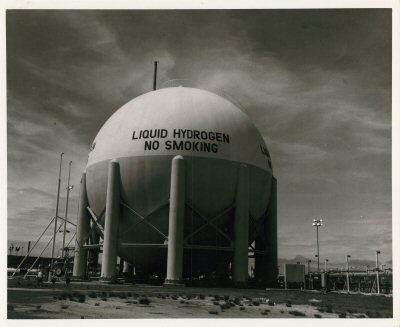
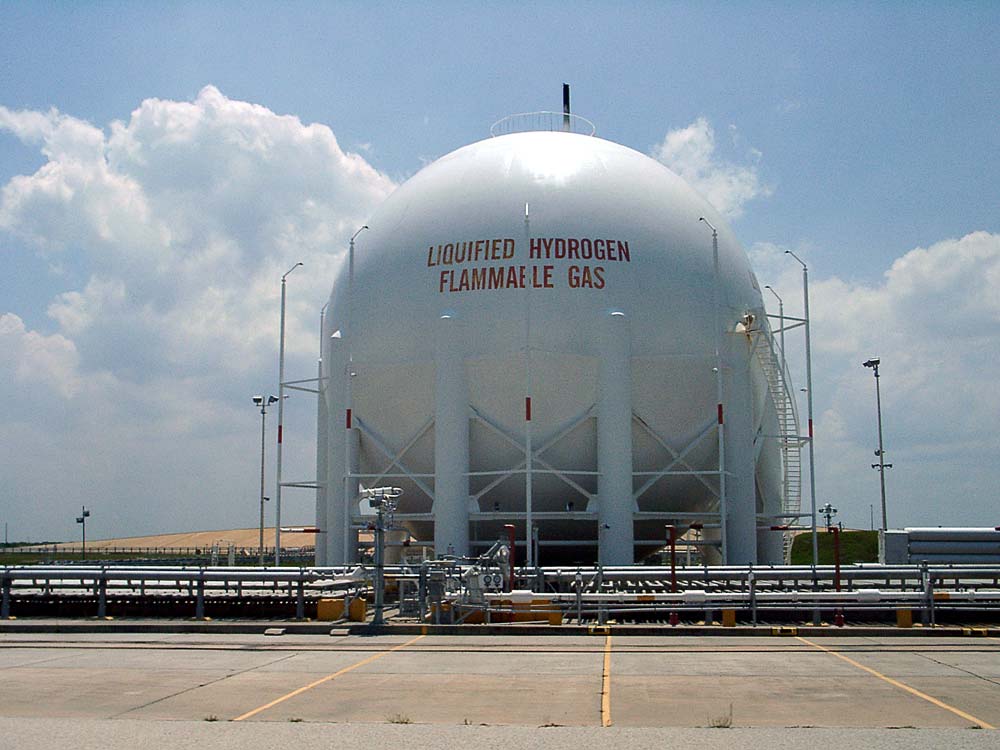
When Launch Complex 39 was built the liquid hydrogen tank (See first photo) was painted per some federal spec with white on top and tan on the bottom and with simply "Liquid Hydrogen, No Smoking".
That worked just fine until OSHS (Occupational Safety and Health Administration) was created in 1970. One day we received a directive that our one of a kind hydrogen tank was not in compliance with OSHA regulations. The proper color was all white and the terminology had to be "Liquified Hydrogen, Flammable Gas" (second photo).
We thought this was pretty ridiculous as the tank is eighty feet in diameter and you can imagine how much paint that is and we kind of like the way it looked and the simplicity of the words. We hemmed and hawed and delayed but were finally threatened with fines (your money, not ours). I put in a work order to have the tank painted per the new design. Obviously this was a massive job with painters in protective berating gear and big spray guns and it took several weeks.
Finally the tank was all white and they started painting the three foot tall lettering. first I questioned the spelling of "Liquified" since the preferred spelling is "Liquefied" but OSHA ruled.
Then one day I went out to see how it was coming along and there's this painter high on his scaffold merrily painting. He had completed "Liquified" and I notice the first three letters of the second word were "NIT", not "HYD". I yelled up to him to stop immediately and that his was a hydrogen tank, not a nitrogen tank. He reached into his coveralls and produced a piece of paper and said," I paint what's on my work order", and continued painting.
I was tempted to let him compile the whole word, "NITROGEN", but didn't and made a few phone calls. Eventually they got it right.
Bet you never heard that one!
1973-1978
I spent five wonderful years launching like the early space pioneers. General Dynamics had only about three hundred people on the whole program at CCAFS versus the tens of thousands on Apollo at KSC. There was no doubt who was responsible when something good or bad occurred on your system on Atlas-Centaur. I worked for Silas Baker and Clay Dennis with Dave Rogers as Lead Engineer. Hank Eskinsen was my mentor while learning the Centaur systems. I was the Centaur Pneumatics engineer and brought some valuable vacuum knowledge to the Centaur program. One of the prime purposes of performing a tanking test was to verify the integrity of the Centaur intermediate bulkhead which separated the oxygen and hydrogen tanks. Almost inevitably the bulkhead would fail its vacuum check under the cryo condition resulting in a myriad of leak checks and another expensive tanking test. I suggested many changes to the Centaur bulkhead hardware and the ground vacuum monitoring equipment which after implementation resulted in never again failing the test. I participated in about thirty Atlas-Centaur launches. With the advent of the Space Shuttle it was announced that all unmanned launch vehicles would be discontinued so I went to KSC in search of some job security. As we know now some 23 years later they are still launching Atlas-Centaus as a result of the Challenger disaster.
1978-1997
I was at KSC interviewing with Rockwell and
James Walker/ Walt Antonewski for ECLSS when Bob Bucina saw me and said
if I was going to work on Shuttle it would be in Main Propulsion.
Bob had been lead engineer on the Liquid Oxygen system on Apollo and we
had worked closely together on that program. He was now Manager of MPS.
This was in 1978 and we didn't have a Shuttle, any test procedures and
no software for the new LPS computerized launch consoles. Many a long hour
was spent learning the system and preparing test requirements, system and
integrated procedures, and the software to operate, control and monitor
everything. Bill Heink was my supervisor and Gary Frank, Bob Bowman
and I prepared almost all of the first round of MPS software and test procedures.
Roy Austin, Ken Kirkland Dick Carlson were instrumental for the SSME group.
It was amazing that everything came together to support a STS-1 launch
in 1981. By that time I was Supervisor of Main Propulsion/SSME and
remained in that position until Lockheed won the Launch Processing Contract.
I stayed with Rockwell as the MPS System Specialist along with Ken Smith,
and later Larry Fineberg, Gary Shirey, Tom Thorson and now astronaut, Frank
Caldeiro.
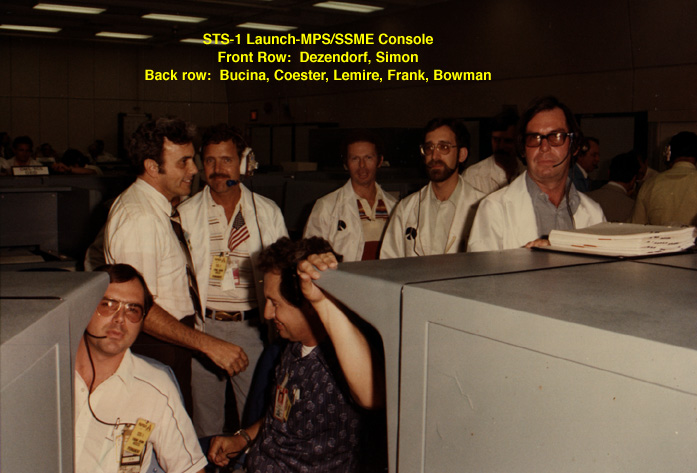
I'll always remember the first Dry CDDT (Countdown Demonstration Test). It took weeks to get through the Count. Now it is routinely a half day test. Also during Dry CDDT in March 1981 where two men were killed after being cleared into the aft fuselage before the inerting nitrogen had been removed. The major fire that virtually enveloped the Space Shuttle after a SSME main fuel valve failed to close following engine abort. Inadvertently dry spinning the LH2 recirculation pumps to 40000 rpm before STS-1, and overpressurizing the MPS helium tanks to almost 6000 psi (4000 psi normal). The discovery of out of round disconnect seals that caused leaks on both 17 inch disconnects and required a roll back to separate the Orbiter from the ET to repair. Developing the leak isolation test that checked out the whole MPS at one time, a major step in reducing processing time. The Big Bangs that shook the whole shuttle stack, blamed on creaky MPS expansion joints but later proven to be caused by TSM (Tail Service Mast) struts. The major modifications to the Orbiter-ET 17 inch disconnects after they slammed closed during flow testing. Removing a leaky Gox disconnect and discovering broken belleville washers. Endless meetings to ensure all criticalites were properly categorized. The same for the OMRSD (Requirements Document). Working with the most excellent engineers at KSC, Houston and Rockwell Downey. Solving problems with John Tribe, Horace Lamberth, Bill Heink, Bob Lang, Phil Cota, Hugh Brasseaux, Don Previtt, Dave Rigby, Harv LeBlanc, Don Jones, Jay Yohinaga, Tom Shupe, Herb Wolfson, John Kremer, Bill Marumoto, Charlie Sosa, Lee Solid, John Sterritt, John Plowden and so many others. Dick Carlson for helping me spell SSME and understand its workings. The whole PSIG (Propulsion Sytems Integration Group). Most significantly, the Challenger Explosion which brought the program and all of us to our knees, only to rise again to greater accomplishments. Getting to know John Young before his first historic Shuttle flight. Working with the Test Conductors and Test Directors who did a fantastic job of integrating everything into a workable Countdown. Being a part of the finest Launch Team on Earth There were so many challenges and always the team came up with solutions.
During my service I was awarded the Silver Snoopy by Astronaut Jim Newman, the Rockwell President's Award (twice), the NASA Manned Space Flight Safety Award, and numerous NASA Achievement Awards.
The Challenger accident affected us all and
after that the job lost much of its thrill for me. The last few minutes
of each subsequent countdown was very emotionally trying for me and made
my decision to retire in 1997 much easier. Click Here for Steve Coester's personal perspective on the Space Shuttle Challenger Disaster. Over the years I helped
launch 115 vehicles into Space, all from the Firing Room or Blockhouse.
When I think of the twists and turns in our paths, I still say, " I can't
think of anywhere else I'd rather have been."